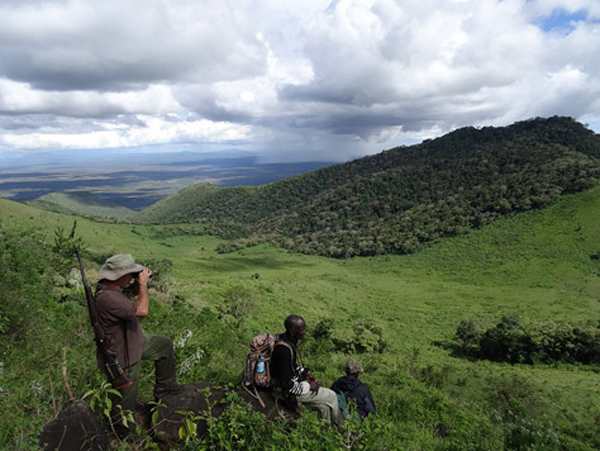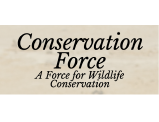
Hunting Cape Buffalo in the Mist Forests of Lossimingor
A first hand account of a Mountain Buffalo hunt in Masailand, Tanzania
I had been mulling this hunt over for many years after an article I had read about hunting on horseback on Mount Longido. After some research I decided to book with Robin Hurt Safaris who have great a reputation. They have the entire Mountain of Lossimingor included within their Burko Masailand hunting concession. Which is where I hunted for 10 days in August.
We hunted the ridges and valleys that span out from a central mass like the arms of an octopus. The ridges are covered with thick vegetation and trees and the slopes can be 45 degrees or greater of loose volcanic soil interspersed with rocky outcroppings, perfect to create problems with footing. The hunting is done by glassing on the top of one ridge to the slope and ridge of an opposing area. You then trek to the opposing slope by descending and ascending the valley between, hoping to gain a foothold above the animals for an approach. This can take hours to accomplish and requires patience and stamina.
Locating your target can be challenging, peering over the edge of the slope into a mass of brush and sorting out how to get into position quietly. The single bachelor bull I harvested was sighted standing in some thick bushes, taking a mid day nap. After four hours of observing him, he finally came out with plans to graze the slope below us. He passed by about 10 feet below us, giving the opportunity for a satisfactory shot.

We found him the following morning. He had gone 200 to 300 foot down the side of the mountain, ending up in a thicket. A party from camp accompanied us, for removal of the meat and trophy on foot. In fact the only time we used vehicles was to gain access to distant parts of the mountain base to begin our mornings. Good boots and flexible ankles help!
The mornings were about 50 degrees with thick cloud cover in the camp, usually clearing up by mid morning. This cover made early morning hunting impossible due to the lack of visibility. We would often leave camp in the clouds, walking out over the ridges to begin our glassing as the clouds receded. Days would often get into the mid 80s, however being in the shade, even during the day could be cool. Other than a few ticks, there was little insect activity. We encountered a very impressive black mamba, who gave us a very calm look over, but didn't see any other snakes. Besides numerous buffalo herds and singles, there were eland everywhere. You couldn't turn a corner or ascend a slope without bumping into them. Bushbuck and their barking was ever present, along with daily encounters of fresh lion and leopard tracks at the areas where water collects. Even several elephant were seen, sliding down the slopes on their backsides.

The trees at the summit were covered with mosses and moisture was dripping off the larger trees, collecting beneath them in pools where the animals drank. Over the ridges and in spots on the slopes were grassy areas with two foot tall grasses. There was ample evidence of animal activity. While I had several opportunities to harvest single bull buffalo, I must admit that even one from this incredible location seemed plenty. It is the most unique environment I have experienced in my thirteen visits to Africa.
I did my best to prepare for this hunt, using guides on preparation for Mount Kilimanjaro as a starting point, but could have done much more and it not been enough. I have never had someone carry my .416 Rigby while hunting, but one day of sliding down slopes and looking for footing while climbing, convinced me that help would make it more likely to complete the hunt! There were times it seemed I might be at an end, but fortunately I was able to hunt everyday and don't think we skimped on anything. By the way, walking sticks are very helpful. They can also serve as pulling sticks, when traversing gouges and gashes in mountain walls. Derek told me that there had been no second visit requests for Mount Losimingor, but I might be it. It was that impressive.
Derek Hurt is a complete professional that expended the effort and knowledge of the environment and it's inhabitants to make my time on Mount Lossimingor so memorable and my best safari yet.
Emery Reynolds, October 2017
Recent Blog Posts
We're attending
The DSC, Texas Trophy Hunters & SCI Conventions
in Jan 2025
Robin Hurt Safaris will be attending three US Hunting Conventions in January 2025. We're looking forward to seeing you there.
A Dangerous Game
By Robin Hurt and other contributers
Safari is what this book is all about. It is dedicated to dangerous game, although not all the chapters are focused on that subject but all describe the danger and excitement of an African safari.






CONTACT US
Robin Hurt Safaris
Cell: +254 (0) 720 783 202
Other: +254 (0) 713 093 726
Email: info@robinhurt.com
Copyright 2024 © Robin Hurt Safaris



